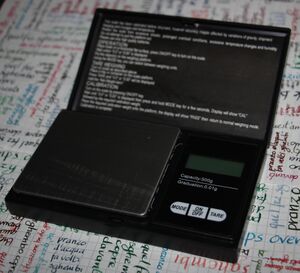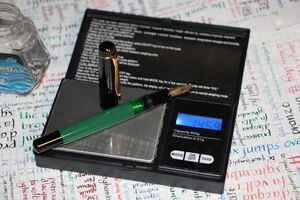Filling systems capacity
One of the criteria with which the filling system is chosen, especially in recent pens, is that of its capacity. It is also one of the criteria on the basis of which we most frequently take sensational dazzles, also because there is a widespread prejudice that a piston filler pen contains much more ink than a cartridge filler one, which, with pens on the market today, is almost never true.
The following table of cartridge capacity is used as a reference (the measures mentioned have been collected on the internet, and have not yet been verified with the methodology adopted later; when they will be, the relevant column will be updated):
| Brand | Type | Capacity | Verified |
|---|---|---|---|
| Pelikan | short | 0,77 ml | no |
| Parker | long | 1.47 ml | no |
| Sheaffer | slim | 1.20 ml | no |
| Sheaffer | standard | 1.50 ml | no |
| Internazional | long | 1.66 ml | no |
For this reason it was decided to start a collection of measures of the actual ink capacity of pens, but for a measure to qualify as such (and not be reduced to a simple statement), it must be repeatable, so in addition to the results of the same, the methodology used to obtain it must also be detailed.
The measurements have been carried out using a scale with sufficient precision, capable to appreciate the hundredth of a gram (of those for weighing gold and jewellery, that you can find for about ten euros on the internet). To give an idea of the order of magnitude, a drop of water from a dropper is between 2 and 4 centigrams.
Prima si è pesato la penna completamente scarica, lavata e lasciata asciugare (in modo da evitare anche lo scarto introdotto dall'inchiostro rimanente nel conduttore) e poi caricata con acqua corrente. Per un confronto che tenga conto del liquido che resta nell'alimentatore, il peso è stato misurato più volte a partire dal primo caricamento da vuota ed asciutta, ripetendo dei cicli di carico e scarico.
First the pen was weighed completely empty, washed and left to dry completely so as to avoid any residue due to ink remaining in the conductor. Left to dry completely means holding the pen upside down with the nib resting on a sheet of absorbent paper for at least a week, so as to exclude any residual water.
Poi si è caricata la penna con acqua corrente. Per un confronto che tenga conto del liquido che resta nell'alimentatore, il peso è stato misurato più volte a partire dal primo caricamento da completamente asciutta, sia dopo il caricamento che dopo averla scaricata, ripetendo più volte il ciclo di carica e scarica.
Il caricamento è stato effettuato normalmente come si fa quando si carica l'inchiosto per scrivere, rimuovendo l'eccesso di liquido dall'alimentatore (scuotendo leggermente per sgocciolare e accostando il pennino al collo della bottiglia) ed asciugando quella eventualmente presente sulla sezione. Si è usata una ordinaria boccetta di inchiostro (Waterman 50 ml, ma una qualunque va bene, basta potervi immergere completamente la punta della penna).
Si sono misurati più volte (almeno 10) sia il peso a penna carica, che a penna scaricata. Dalle varie misurazioni si è ottenuto il peso a penna carica e scarica calcolando media e deviazione standard. Non ha senso infatti utilizzare il valore più alto, il caricamento perfetto non esiste, quello che costituisce una indicazione di quanto nell'uso ordinario la penna carica davvero, è la media.
We measured several times (around 10) both the weight when the pen is loaded and when the pen is unloaded; the latter is used to estimate how much liquid remains in the feeder, but we took as an indication of the filling capacity the value with the pen fully filled, because pens are filled once the ink is finished and no longer reaches the nib, and this also includes the one present in the feeder. From the various measurements we obtained average and standard deviation.
The capacity in ml was then determined using the specific weight of the water which is 0,997 g/ml. The difference between tap water and pure water is below the appreciable limits of the measurement in centigrams, and inessential for the measurement whose accuracy is ±0.02 ml (sum of the systematic error of 0.01 g of the scale in the difference between two measurements, even if the error is always higher for a filled pen weight measurement), for the conversion, however, we can substantially assume an equivalence of 1 g => 1 ml being the difference below the measurement error.
Results
| Pen | Type | Empty | Filled | Unloaded | Capacity |
|---|---|---|---|---|---|
| Pelikan 140 | piston | 14,33 ± 0,01 g | 15,98 ± 0,04 g | 14,59 ± 0,03 g | 1.65 ± 0,05 ml |
| Duofold De Luxe | button | 22,10 ± 0,01 g | 24,00 ± 0,03 g | 22.35 ± 0,03 g | 1.90 ± 0,04 ml |
| Lamy 2000 ('60s) | piston | 20,88 ± 0,01 g | 22,68 ± 0,02 g | 21,59 ± 0,02 g | 1.80 ± 0,03 ml |
| Pelikan 481 | piston | 12,97 ± 0,01 g | 14,60 ± 0,01 g | 13,29 ± 0,01 g | 1,63 ± 0,01 ml |

